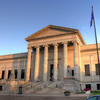More about Christ Driving the Money Changers from the Temple

Contributor
El Greco’s Christ Driving The Money Changers From The Temple is an easy painting to decipher if you just update the scene with a 21st century sensibility.
It’s simple, really. If the temple is a nightclub, then Jesus is the bouncer. Or maybe the temple is a classroom, and Jesus is the fed up teacher kicking out the loud mouthed kids. Personally, I like to see the temple as a movie theater, and Jesus as an usher kicking out people who won’t get off of their phones. These analogies aren’t perfect. But you get it. I know you do.
At first glance, the first thing that struck me was how meme-able this painting is. You can apply it to so many different scenarios, and it always makes sense within the context of the story in the painting. But as I did more research, I came to the conclusion that the point of this painting kind of was to be a meme, even if El Greco was a painter from the 16th century who had no idea what a meme was.
But before we go there, we need a bit more context about what this painting actually is. The scene that it’s depicting is a story from the bible called “The Cleansing of the Temple” in which Jesus is throwing out merchants and other slimy types from the house of God because that seedy type of business doesn’t belong within those four divine walls of worship. El Greco is proclaiming through Jesus in no short manner, “Ayo, y’all ain’t gotta go home but you gotta get up outta here” or “Get these bums outta here before my dad finds out you were trying to make a quick buck in his house.” Jesus isn’t happy with this situation, and El Greco conveys it pretty well.
El Greco’s angry Jesus masterpiece was part of a movement called the Counter-Reformation. And the exploits of that movement basically boil down to the fact that the Roman Catholic church felt like they were losing the tight grip they had on the world to the Protestants, so they took initiative and tried to get back into everyone’s good graces again. The movement is essentially a propaganda tactic with the sole purpose rooted in convincing the masses that their way of faith was better than others. See where the memeability comes into play? Even though they didn’t think of it in the same way, the Catholic Church was enabling people to create art on their behalf that could be broadly relatable enough that it could serve as a blanket representation of what they were about.
Sounds a lot like a meme to me. The only problem is that these are kind of like Boomer memes. They’re the type your parents share on Facebook and send you on occasion thinking it’s the funniest thing in the world but you can’t help but roll your eyes. We get it, Catholic Church, you want to stay relevant. Despite how childish or suspiciously marketing-conscious it may seem, Counter-Reformation sensibilites informed much of late Renaissance, Mannerist, and Baroque art, and without it, we wouldn’t have gotten this painting or many others by artists like Caravaggio, Bernini, and Zurbarán.
El Greco was so taken by this scene, and the obvious power that it holds, that he painted it six different times in total. Each one is a little different than the one before it. And his influences of the time are always very prevalent. So in a way, my guy El Greco kept this meme alive for a very long time by simply changing the filter. What a genius. Whether you see the painting for its meme potential or appreciate it for its historical context, one thing is certain: Jesus has had absolutely enough of these fools.
Sources
- Allen, Bryan T. “El Greco, Mystical Renegade”. National Review. February 8, 2020. https://www.nationalreview.com/2020/02/art-review-el-greco-show-paris-f…
- Britannica. “Counter-Reformation”. Accessed May 15, 2020. https://www.britannica.com/event/Counter-Reformation
- Fiore, Julia. “How El Greco’s Expressive Paintings Inspired Artists from Velázquez to Van Gogh.” Artsy. September 26, 2018. https://www.artsy.net/article/artsy-editorial-el-grecos-expressive-pain…
Featured Content
Here is what Wikipedia says about Christ Driving the Money Changers from the Temple (El Greco, Minneapolis)
Christ Driving the Money Changers from the Temple is a 1571 Christian art painting by El Greco, now in the Minneapolis Institute of Art. It depicts the Cleansing of the Temple, an event in the Life of Christ.
There exist three other copies of the painting and also a faithful reproduction in the National Gallery in London, which has recently been considered as authentic by scholars in the field of visual arts. Two versions and that other on loan from Madrid are titled Purification of the Temple. The one at the National Gallery in Washington is called Christ Cleansing the Temple.
Check out the full Wikipedia article about Christ Driving the Money Changers from the Temple (El Greco, Minneapolis)













This painting has a good visual depth and very vibrant colors. The artist defiantly took some creative liberty and incorporates a lot of renaissance imagery into this first-century story.